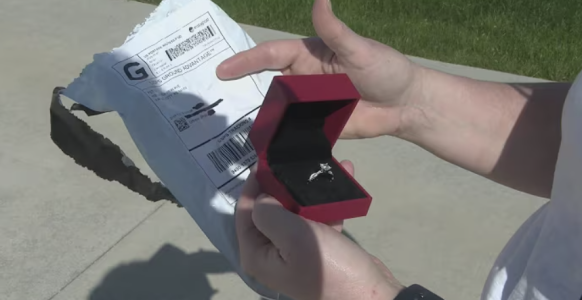Are mysterious packages showing up at your door? Here’s what USPS wants you to be aware of
- Replies 0
Have you ever opened your front door to find a package you never ordered, addressed to you, with no clue who sent it?
Maybe it’s a cheap trinket, a pair of socks, or a gadget you’d never buy. You might be tempted to chalk it up to a shipping error or a secret admirer.
But before you start guessing, the United States Postal Service (USPS) wants you to know: you could be the latest target of a sneaky scam called “brushing”—and that’s just the tip of the iceberg.
The “brushing” scam is a new twist in the ever-evolving world of fraud. Here’s how it works: shady online sellers send out unsolicited packages to random people.
Why? Because once the item is delivered, the seller can post a fake “verified purchase” review using your name and address, making their products look more popular and trustworthy than they really are.
It’s a clever way to game the system, but it’s also a red flag that your personal information is floating around in places it shouldn’t be.

Brushing is just one of many scams the USPS is warning about. According to Postal Inspector Damien Kraebel, scammers are getting more sophisticated every day.
From classic lottery and Publisher’s Clearinghouse scams to romance and employment cons, these fraudsters are targeting Americans of all ages—but especially older adults, who are often seen as more trusting or less tech-savvy.
The most common tactics? Phishing (fraudulent emails) and smishing (fraudulent text messages).
These messages often look like they’re from the USPS, claiming there’s a problem with a package or asking you to click a link to track a delivery.
But don’t be fooled—these are designed to steal your personal information, and sometimes even your money.
You might be thinking, “So what if someone sends me a free gadget?” But the real danger is that your name, address, and possibly other personal details are being used without your consent.
This information could be sold to other scammers, leading to more serious fraud down the line—like identity theft or financial scams.
And once your information is out there, it’s tough to get it back.
As Inspector Kraebel points out, international scammers are hard to track down, and recovering lost money or stolen identities can be a long, frustrating process.
The USPS isn’t taking this lying down. In 2023, they launched “Project Safe Delivery,” a nationwide effort to crack down on mail-related crimes.
The results are promising: a 27% drop in letter carrier robberies and over 2,800 arrests in just one year. But as scammers get smarter, the fight is far from over.
If you suspect a scam, you should monitor your credit accounts, consider freezing your credit, and forward suspicious USPS-related emails to [email protected] or scam texts to 7726 for investigation.
Watch out for more scams:

Have you ever received a mysterious package or a suspicious message claiming to be from the USPS? How did you handle it? Do you have tips for spotting scams or stories to share? Drop your experiences and advice in the comments below.
Maybe it’s a cheap trinket, a pair of socks, or a gadget you’d never buy. You might be tempted to chalk it up to a shipping error or a secret admirer.
But before you start guessing, the United States Postal Service (USPS) wants you to know: you could be the latest target of a sneaky scam called “brushing”—and that’s just the tip of the iceberg.
The “brushing” scam is a new twist in the ever-evolving world of fraud. Here’s how it works: shady online sellers send out unsolicited packages to random people.
Why? Because once the item is delivered, the seller can post a fake “verified purchase” review using your name and address, making their products look more popular and trustworthy than they really are.
It’s a clever way to game the system, but it’s also a red flag that your personal information is floating around in places it shouldn’t be.

The “brushing” scam is a new twist in the ever-evolving world of fraud. Image source: WCIA News / YouTube
Brushing is just one of many scams the USPS is warning about. According to Postal Inspector Damien Kraebel, scammers are getting more sophisticated every day.
From classic lottery and Publisher’s Clearinghouse scams to romance and employment cons, these fraudsters are targeting Americans of all ages—but especially older adults, who are often seen as more trusting or less tech-savvy.
The most common tactics? Phishing (fraudulent emails) and smishing (fraudulent text messages).
These messages often look like they’re from the USPS, claiming there’s a problem with a package or asking you to click a link to track a delivery.
But don’t be fooled—these are designed to steal your personal information, and sometimes even your money.
You might be thinking, “So what if someone sends me a free gadget?” But the real danger is that your name, address, and possibly other personal details are being used without your consent.
This information could be sold to other scammers, leading to more serious fraud down the line—like identity theft or financial scams.
And once your information is out there, it’s tough to get it back.
As Inspector Kraebel points out, international scammers are hard to track down, and recovering lost money or stolen identities can be a long, frustrating process.
The USPS isn’t taking this lying down. In 2023, they launched “Project Safe Delivery,” a nationwide effort to crack down on mail-related crimes.
The results are promising: a 27% drop in letter carrier robberies and over 2,800 arrests in just one year. But as scammers get smarter, the fight is far from over.
If you suspect a scam, you should monitor your credit accounts, consider freezing your credit, and forward suspicious USPS-related emails to [email protected] or scam texts to 7726 for investigation.
Watch out for more scams:
- Maryland man loses $40K to convincing scam—here’s how to protect yourself
- Bitcoin scam nearly cost a 73-year-old $20,000—here’s how she was saved
Key Takeaways
- The United States Postal Service is warning customers about increasingly sophisticated phishing and smishing scams targeting personal information, including package tracking and fake USPS messages.
- A growing threat known as "brushing" scams involves receiving unsolicited items from sellers, who then use fake reviews online to boost sales.
- Postal officials advise people to be wary of messages with country codes or errors, and to never click links in messages claiming to be from USPS, as authentic USPS texts never contain clickable links.
- If you suspect a scam, you should monitor your credit accounts, consider freezing your credit, and forward suspicious USPS-related emails to [email protected] or scam texts to 7726 for investigation.






